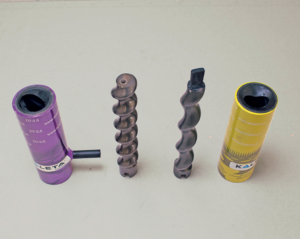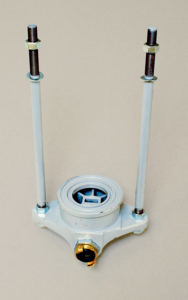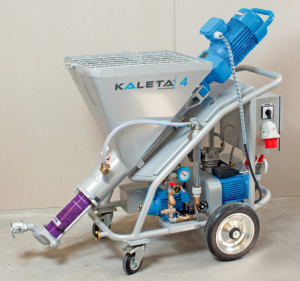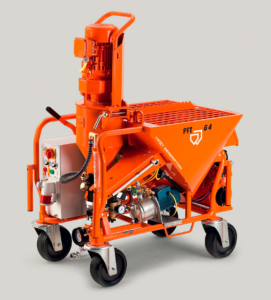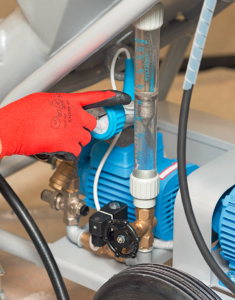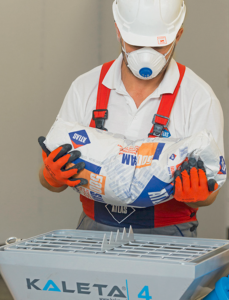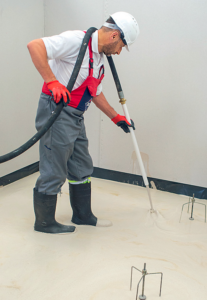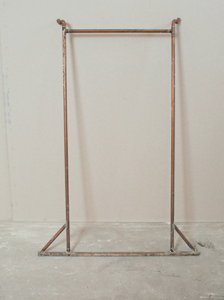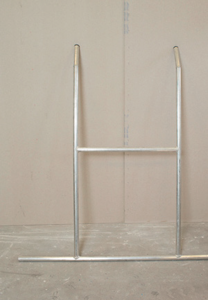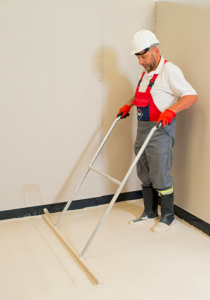- Products
- Systems
- Tools & Services
News
Machine application of Atlas screeds
The building market is subject to constant changes. Investors expect the projects to be carried out fast and in high quality. The manufacturers of building materials offer products based on new technologies which make it possible to work quickly at every stage of construction work.
Price is no longer the only factor determining the technological and material solutions. In many EU countries, after years of stagnation, it is time of rapid growth in the construction industry. For example, in Poland in the first quarter of 2017 the number of completed new flats increased by 7.8% compared to the previous year, whereas the number of flats under construction (in the same period) increased by 28.9%! We’re building more and more and investors have understood that they need to build quickly to stay competitive. Fast technologies displace time-consuming ones. Nowadays, it is difficult to imagine application of gypsum or cement-lime plasters in other
way than mechanically with a specialist unit. In the field of floor screeds the material consumption per 1 m2 is 80-100 kg (in the case of screeds on the separating layer or on the underfloor heating). No wonder that here the use of machines is already a standard. So far the most commonly used technology is the one which involves the material preparation in a special mixer. Material is pumped by a spiral pump and transported directly to the place where the floor is to be constructed.
Material dosing, i.e. aggregate, cement and optionally a plasticizer, is done manually in a volumetric manner. Mixture of thick-dense consistency (the consistency of wet soil) is spread with a long batten and mechanically troweled. Technical parameters of so applied screed depend on the degree of volumetric dosing accuracy. Final strength parameters can be therefore less or more random. The advantage of this technology is its high capability and price. The alternative to these screeds is offered by self-leveling screeds applied with the use of mixing and pumping units – similar to the ones used for machine plastering. The recipes of ready-made Atlas screeds, in particular Atlas POSTAR 100 and screeds of Atlas SAM and Atlas SMS lines were designed with view to machine application from very beginning. The greater part of their validation took place in facilities where the mix was prepared and applied with the use of mixing and pumping units.
Machine application – advantages
PERFORMANCE
It is obvious that machine application with a mixing and pumping unit definitely speeds up the processes of preparation
and transportation of the ready-to-use mix. Table 1 shows the size of areas which can be covered with manual and machine method with a unit of efficiency of 35 l/min. The table includes the most popular self-leveling ATLAS screeds given that the application lasts an hour and is continuous.
Tab. 1 Comparison of performance of manual and machine application.
|
Screed |
Consumption per 1 cm of thickness |
Layer thickness |
Kilograms |
Number of m2 for manual application* |
Number of m2 for machine application* |
|
SAM 100 |
20 |
3.0 |
60 |
10 |
70 |
|
SAM 200 |
20 |
5.0 |
100 |
6 |
42 |
|
SAM 500 |
18 |
5.0 |
90 |
6.7 |
47 |
|
SMS 15 |
16.6 |
1.5 |
25 |
24 |
168 |
|
SMS 30 |
16.6 |
3.0 |
50 |
12 |
84 |
|
POSTAR 100 |
20 |
5.0 |
100 |
6 |
42 |
*layer thickness as listed in the table.
QUALITY
In addition to the performance, another important advantage of machine technology is the quality of the prepared screed. There are several factors that make a difference. ATLAS guarantees perfect and stable technical product parametres – state-of-the-art technology and procedures of control of manufacturing ensure repeatable quality of each bag of product.
Once and for good – perfect material parameters
Another advantage results from the method of the material preparation. Mixing and pumping unit mixes the dry mix with water and pumps the compound at a distance uniformly within the whole application cycle, which ensures stable working parameters of mortar. Once set, the product consistency (resulting from the amount of added water) is assured all the time during application, even in the case of a break in the unit’s operation. The advantage of constant consistency is unchangeable, excellent homogeneity of the mix. The mass prepared by the unit will never be aerated too much, which often happens in case of manual mixing. The bonded screed will not be vulnerable to shrinking and the surface will be homogeneous and smooth.
The advantage of the machine application over the manual one
The advantages of a machine application absolutely do not discriminate against the manual application, because whenever the manufacturer’s instructions are followed, in both cases we will obtain a product of the same consistency. But let’s assume the following situation: We need to apply a screed made of Atlas SAM 200 or Atlas SAM 500 upon an area of 100 m2 with 5 cm thick layer (typical screed with an underfloor heating embedded). When a manual application is carried out, we must prepare 400 buckets of ready compound – it means there would be 400 water ratio measurements needed, the mix would need to be mixed uniformly 400 times, then each bucket would need to be carried, poured at the place of application, only then the compound would be spread, finally the buckets would be cleaned. Even in the case of mortar preparation in-situ, there will be dozen aggregate, cement and water additions. In both situations a mistake is much more likely to happen in comparison to machine application with a specialist unit. With an unit we set the water/dry mix ratio or the expected consistency only once and thus we provide identical technical and working parameters all the time, no matter how fast we fill the unit container with the dry mix.
UNIT
Each plastering unit can be used to apply self-leveling screeds after some adjustment. What does it look like? Below there is a list of actions and parts to be replaced so that the unit is adapted for screeds.
1. We change the pump. Plaster application usually requires pumps of efficiency of 25 l/min. When talking about the screeds, we should use a pump of 35 litres efficiency. Photo 1 shows two different pumps: for plaster application
(on the left) and for screed application (on the right). A perpetual screw for screeds has less turns, so the unit will produce more mortar in the same time.
2. We attach an additional mixer – an aerator (directly under the pump). It is responsible for additional mixing of already wet mortar (photo 2). It is necessary in case of application of screeds more than 50 mm thick.
3. We change the delivery hoses – from 25 mm of diameter to 35 mm of diameter.
4. We disconnect the compressor and a spray gun – they will not be necessary as the material is pumped and poured from the delivery hose directly on the substrate.
The adjustment is necessary whenever we intend to pour thick screeds, i.e. at least 3 cm thick, e.g. Atlas SAM 200, Atlas SAM 500 or Atlas POSTAR 100. Consumption per 1 m2 will vary between 50 and 120 kg/m2.
|
NOTE! When we intend to use the unit to apply thin-coat self-leveling compounds (e.g. Atlas SAM 100, Atlas SMS 15, Atlas SMS 30) on the area which does not exceed 100 m2, the adjustment is not necessary. A typical pump and a small hose diameter provide sufficient efficiency. The material coverage (per 1 m2) in the case of application of products indicated above is between 40 and 50 kg/m2. |
In order to ensure appropriate pace of the unit’s operation, therefore high application efficiency, one must adjust the unit. Estimated cost of such adjustment – which is an overall cost of more efficient pump, extra mixer and wider hoses (35mm diameter) is about 250 Euros. The principle of operation and construction of each pumping-mixing unit are identical.
|
Machine application of screeds STAGE 1. The first actions are: preparation of the substrate and determination of the level of the screed, then the execution of wall and intermediate expansion joints. This stage is identical for both methods of application: the substrate should be stable, dry and tight because of liquid consistency of self-leveling screeds. It is advisable to use ATLAS expansion profiles to carry out wall or threshold expansion joints. STAGE 2. Mortar preparation (determination of the consistency). When the screed is manually applied, water is measured according to the ratio indicated on the packaging (e.g. 5-5.25 l/25 kg bag for SMS 15), then the material is poured to the water, the mass is carefully stirred and poured on the substrate. In the case of machine application we do not add water manually. The dry mix is poured into the container and the unit automatically doses the one and water. To obtain appropriate consistency of mortar we need to set the mixing ratio correctly. In case of self-leveling screeds we do it in the following way: We adjust the floater in the flow tube at a level of not less than 800 ml. Then we set the consistency for so determined water level. To do so we check the diameter of the mortar circle poured from a 1 litre container on a plastic foil. If the patch diameter is larger than indicated in the table no. 2, we reduce the water level by screwing knob at the indicator (photo 5). We follow this pattern until we receive the diameter within the required range. Correct diameters for self-leveling screeds are given in the table 2.
NOTE! We always start the determination of water volume from upper level and gradually reduce it until the float indicates the level at which correct consistency is provided. Water level can differ between two similar applications – despite of the fact that we might work with the same unit and the same product. Therefore, to protect from clogging the hose, we always have to start from upper water level.
Table 2: Diameters of self-leveling screed patches
STAGE 3. Pouring the mortar. We pour the material into the container by cutting the bags on the cover crest (photo 6). Let’s remember to place the pallets with bags close to the unit. If there is much material to be poured into the container (piled on several dozen pallets), it is reasonable that two workers handle it. In contrast to plasters, self-leveling screeds have larger density (and weight). Therefore, the container should not be full at any point of operation. The hose should be led just above the level of the screed, so the mortar does not get aerated. We pour the mortar on the entire surface, in a continuous manner, with layers 1-2 cm thick. Due to the weight of the hose with mortar it is helpful to put the hose over the shoulder (photo 7). STAGE 4. Leveling (de-aeration). During the design and validation processes we checked the mortar aeration level (regards to SMS and SAM compounds). Atlas determined the aeration level to make the bonding process smooth and troublefree. We obtain smooth surface with no blisters. For venting and leveling screeds applied upon large areas we recommend to use specialist rake made of light materials, e.g. aluminum or copper bars (photo 8 and 9). For venting thin-coat self-leveling masses (layer thickness up to 30 mm) we recommend to use rake made of copper tubes, whereas for anhydrite screeds (layer thickness up to 60 mm) it is the best to choose aluminum rake with long horizontal bar (1.5 m). De-aeration is done with shaking movements in two crisscrossing directions (photo 10). |
In practice
Investors’ expectations require the contractor to carry out the application quickly and to keep high quality of work. Very often even a retail individual consciously chooses the technological solutions and materials. A modern investor does not only follow the price. A good example is the floor heating, which in single-family housing is almost a standard. This type of heating requires the screed to surround the installation pipes tightly. Smooth consistency of Atlas SAM 200 or Atlas SAM 500 meets these requirements. Cement screeds of thick-plastic consistency leave cavities filled with air under the pipes, which then block the transfer of heat from the heating system to the screed. No wonder then that self-leveling anhydrite floors have replaced cement screeds in case of this heating technology. For surfaces up to 120 m2 large the machine application of anhydrite screeds (Atlas SAM 200, Atlas SAM 500) with an unit is an optimal solution.
Atlas SAM 500 is a one of our newest products. Like every anhydrite screed, it suits perfectly for underfloor heating, in addition it is fast-setting – one can access the floor and continue further work already after 6 hours. Renovations and other indoor installations in facilities like schools, hospitals etc. require perfectly smooth substrates under seamless flooring, e.g. Tarkett. Machine application with the use of e.g. Atlas SMS 15 or Atlas SMS 30 (perfectly even and smooth screeds) allows us to apply more than 400 m2 in a single day of work.
Summary
Change in the method of application (quick pace) and good prosperity in the construction industry will make the machine application technologies even more popular within the next 2-3 years. ATLAS is ready to help contractors
regarding machine application of our products of SAM, SMS and POSTAR lines. In case of any questions please do not hesitate to contact our technical advisors.
Check our “School of Flooring” brochure available for download on: www.atlas.com.pl/en
Original text: Krzysztof Szyszko, ATLAS Group
English text: Piotr Marciniak, Michał Gosławski, ATLAS Group
